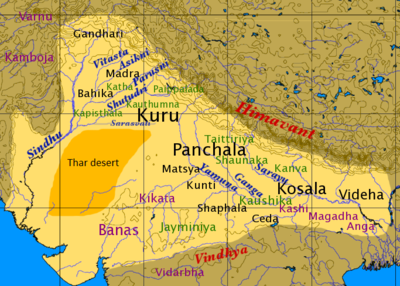Kingdom of the Videhas
Kingdom of Videha | |||||||
|---|---|---|---|---|---|---|---|
| ~before 1200 BCE–550 BCE | |||||||
 The Kingdom of the Videhas (Mithila) and other kingdoms of the late Vedic period | |||||||
| Capital | Mithila, which could either be Janakpur (in present-day Nepal),[1] or Baliraajgadh (in present-day Madhubani district, Bihar, India).[2][3] | ||||||
| Common languages | Sanskrit | ||||||
| Religion | Vedic-Hinduism[4] | ||||||
| Government | Monarchy | ||||||
| Janaka | |||||||
| Historical era | Iron Age | ||||||
• Established | ~before 1200 BCE | ||||||
• Disestablished | 550 BCE | ||||||
| |||||||
| Today part of | India Nepal | ||||||

The Kingdom of the Videhas (also known as Mithila[5] and Tirabhukti[6]) was an ancient Indian kingdom in Late Vedic India[7] which rose to prominence under King Janaka (c. 8th-7th centuries BCE). The ancient kingdom's territory is located in Mithila region on the northern part of the Indian subcontinent, what is today northeastern Bihar of India and the eastern Terai of Nepal.[6][7]
History[]
During the late Vedic period (c. 900 – c. 500 BCE), Videha became one of the major political and cultural centers of Ancient India, along with Kuru and Pañcāla.[8] Late Vedic literature such as the Brahmanas and the Brihadaranyaka Upanishad both mention Janaka, as a great philosopher-king of Videha, renowned for his patronage of Vedic culture and philosophy, and whose court was an intellectual centre for Rishi (sages) such as Yajnavalkya.[9] Raychaudhuri suggests 8th- to 7th-century BCE range, while Witzel suggests c. 750 to 500 BCE for the Brahmanas and Upanishads composition period in Videha.[10][note 1] The Vedic school of Aitareyins probably moved to Videha and other centers of scholarship, during the late Vedic period.[11]
The region and culture of Videha is often mentioned in Hindu literature.[12] The texts mention the idea of royal dynasty and the tradition of philosopher-kings who renounce, with examples including Nami (or Nimi in some texts), Janaka and other kings.[12] Their stories are found in ancient surviving Hindu, Buddhist and Jaina texts, suggesting that renunciation by kings was a respected tradition before the birth of Buddha, and that this tradition was also broadly accepted in regions other than Videha, such as in Pancala, Kalinga and Gandhara.[12] King Nimi or Nami of Videha is included as the 21st of the twenty four Tirthankaras in Jainism (not to be confused with closely spelled Nemi, the 22nd Tirthankara).[12]
Towards the end of the Vedic period, Videha likely became part of the Vriji (Pali: Vajji) confederation and subsequently into the Magadha empire.[13][14] The Videha kingdom is also mentioned in the Sanskrit epics, the Mahabharata and the Ramayana. In the Ramayana, Sita is the princess from Videha,[12] who marries Rama creating an alliance between the kingdoms of Kosala and Videha.[1] The capital of Videha is believed to be either Janakpur (in present-day Nepal),[1] or Baliraajgadh (in present-day Madhubani district, Bihar, India).[2][3]
According to the Digambara Uttarapurana text, Mahavira was born in Kundpur in the Kingdom of the Videhas.[15]
See also[]
- Maithil
- Mahabharat
- Vedic period
- Mithila, India
- Mithila (region)
- History of India
- History of Hinduism
- History of Mithila Region
- Ancient Mithila University
- Janapada & Mahajanapada
- Other kingdoms
Notes[]
- ^ Raychaudhuri notes that the Puranic chronology would extend the possible range back to the 12th century BCE, but considers this to be of limited value, and necessary to treat with caution (pp.27–28).
References[]
Citations[]
- ^ a b c Raychaudhuri (1972)
- ^ a b "News18 इंडिया: Hindi News, Latest News in Hindi, Breaking News in Hindi".
- ^ a b "Archived copy". Archived from the original on 26 October 2017. Retrieved 26 October 2017.
{{cite web}}: CS1 maint: archived copy as title (link) - ^ Ben-Ami Scharfstein (1998), A comparative history of world philosophy: from the Upanishads to Kant, Albany: State University of New York Press, pp. 9-11
- ^ http://lrc.bih.nic.in/Gazetteer/Saharsa/chapter-II.pdf
- ^ a b Dilip K. Chakrabarti (2001). Archaeological Geography of the Ganga Plain: The Lower and the Middle Ganga. Orient Blackswan. pp. 207–. ISBN 978-81-7824-016-9.
- ^ a b Michael Witzel (1989), Tracing the Vedic dialects in Dialectes dans les litteratures Indo-Aryennes ed. Caillat, Paris, pages 13, 17 116-124, 141-143
- ^ Michael Witzel (1989), Tracing the Vedic dialects in Dialectes dans les litteratures Indo-Aryennes ed. Caillat, Paris, pages 13, 141-143
- ^ H. C. Raychaudhuri (1972), Political History of Ancient India and Nepal, Calcutta: University of Calcutta, pp.41–52
- ^ Michael Witzel (1989), Tracing the Vedic dialects in Dialectes dans les litteratures Indo-Aryennes ed. Caillat, Paris, pages 13, 39-46, 141-143
- ^ Michael Witzel (1989), Tracing the Vedic dialects in Dialectes dans les litteratures Indo-Aryennes ed. Caillat, Paris, pages 76-77, 125
- ^ a b c d e Geoffrey Samuel, (2010) The Origins of Yoga and Tantra: Indic Religions to the Thirteenth Century, Cambridge University Press, pages 69-70
- ^ H.C. Raychaudhuri (1972), pp. 70-76
- ^ Raychaudhuri Hemchandra (1972), Political History of Ancient India, Calcutta: University of Calcutta, pp. 85–86
- ^ Pannalal Jain 2015, p. 460.
Sources[]
- Jain, Pannalal (2015), Uttarapurāṇa of Āchārya Guṇabhadra, Bhartiya Jnanpith, ISBN 978-81-263-1738-7
- Mahabharata of Krishna Dwaipayana Vyasa, translated to English by Kisari Mohan Ganguli
- The Geography of India: Sacred and Historic Places. Britannica Educational Publishing. April 2010. ISBN 9781615302024.
External links[]
- Mithila
- Dynasties of India
- Kingdoms in the Ramayana
- Kingdoms of the Ikshwaku clan
- Historical Indian regions
- History of Bihar
- Populated places in Mithila, India
- 2nd millennium BC in India
- 1st millennium BC in India
- 15th-century BC establishments
- 6th-century BC disestablishments in India
- Dynasties of Nepal
- 1st millennium BC in Nepal
